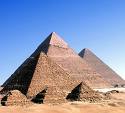
 Catching the Egyptair flight from Cairo to Mumbai, I watch the man next to me cross himself a few times. It has been an eventful month, starting with a cruise on the Nile and ending with guided tours of the Citadel, Coptic Cairo, the Egyptian Museum, the Pyramids and the Sphinx at Giza.
Catching the Egyptair flight from Cairo to Mumbai, I watch the man next to me cross himself a few times. It has been an eventful month, starting with a cruise on the Nile and ending with guided tours of the Citadel, Coptic Cairo, the Egyptian Museum, the Pyramids and the Sphinx at Giza.From Agatha Christie to Edward Said, Egypt has attracted thousands of scholars, archaeologists and writers. A traveller brought up on all these stereotypes needs to discover Egypt for himself.
Cairo is a modern city, though a little maddening at times. The Nile runs through it and on the cruise on the river from Luxor to Aswan, one feels the all-pervading influence of the past. Five thousand years of history lie encrusted here. At the Karnak and Luxor temples on the east bank, and the Valley of the Kings and Queens on the west, one senses a vast Pharaonic necropolis. At the Karnak temple, the hall is full of pillars that look like a clump of papyrus shoots or lotus stems. These plants symbolise upper and lower Egypt, united under the Pharaohs. Like the Nile flowing through the land, this theme runs through the ancient temples of the Pharaohs: Papyrus and Lillies.
At the Emperor Saladin’s Citadel, I enter the mosque built by Muhammed Ali Pasha. A hush descends as we take off our shoes and walk inside. The Military Museum reminds you of the turbulent history of the Middle East. The next visit is to the Egyptian Museum. Our guide, Miss Hooda, shows us the Royal Mummies, which send a shiver down my spine. Shrunken and embalmed, they lie as they must have lain thousands of years back. Tutankhamen’s treasures come next, all solid gold jewellery, arms, clothes and also the flowers his wife laid for him. A replica of the Rosetta Stone (the original lies in the British Museum) with a cartouche around the name of the Pharaoh, was used to decipher the hieroglyphs. Squeezing past Russian tourists, our guide holds aloft a fan to guide us through the building. We drive through the city with the Nile flowing by. Sitting at a restaurant, I watch an Egyptian woman smoking the shisha.
Coptic Cairo is a must with the Coptic Museum at the centre. The manuscripts found at Nag Hammadi have given rise to the theory mentioned in Dan Brown’s book The Da Vinci Code. Among other highlights were the ornate palanquins used by pilgrims to go to Jerusalem. The Hanging Church comes next. It’s built on two Roman pillars, and you can look down from a peephole built on the floor. The old Jewish Synagogue is situated in the heart of Coptic Cairo. It was once a church, and the site of a dispute settled by the Emir. There is a marble platform for Torah reading in the centre, and pews for worshippers to sit on.
Living in Maadi is a wonderful experience with the Maadi Grand Mall, Road 9 and Church of the Floating Gospel in close proximity. The Church of the Floating Gospel is situated on the Nile, and it is said that a Bible was found floating on the waters and that is where the church was built. Maadi Grand Mall is a modern shopping complex where we picked up galabiwyas (kaftans) from an old Bedouin shop. Road 9 is the Maadi equivalent of the Khan-el-Khalili, loaded with gifts like scarabs, mini pyramids and papyrus paintings. Unlike Khan-el-Khalili, there is no bargaining here.
Khan-el-Khalili is the heart of Islamic Cairo. An ancient market, it sells wares of all sorts, from curios to gifts and souvenirs. There is a famous café, Al-Fishawi, which has been running for two hundred years. In another café, Naguib Mahfouz used to sit and write. It is now owned by the Oberois, and is completely modern. Haggling is the key to all purchases in Khan-el-Khalili.
All in all, Cairo leaves you with a sense of contradictions. Areas like Maadi and Zemalik, where expatriates live, are modern and cosmopolitan. However, other parts of the city such as the City of the Dead where people live inside graveyards, and the medieval city with its remnants of the city wall, gates and mosques, show a different picture.

Be the first to comment